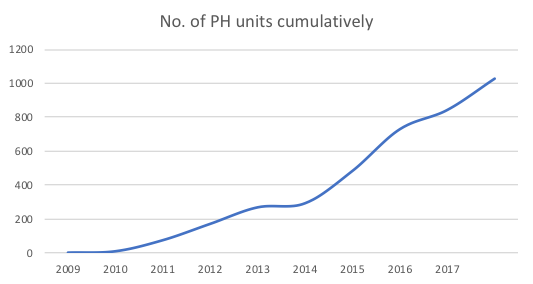Search the Community
Showing results for tags 'passive house'.
-
Hi all, We've been slowly doing a retrofit over the past two years or so with the aim to get Enerphit certification. We have done a PHPP with the help of a passive house designer. Current status is this: half of the windows and the front door have been replaced with passive certified components. We have an MVHR installed (hard work retrofitting this, but it is in). We've just put in a new kitchen, done three bathrooms. We plan to rebuild the upstairs, replace the rest of the windows, replace the roof with insulation etc. We will certainly struggle with air-tightness. While doing all this, I am now wondering if it makes sense to continue this further, or knock down the house and rebuild from scratch as a fully certified passive house, perhaps using ICF for speed of construction. I'm trying to build a business case for this with the following approach: - We use the current windows and front door in the new plan. - We use most of the components in the three bathrooms we have just done up including shower trays, glass partitions, toilets, furniture etc. - We use the new kitchen and appliances we have just put in. - We use the MVHR unit but redo the ducts in the new house. - We save money with reduced energy bills over say 15 years, compared to the current house or even become net zero positive with solar. - We are planning to rebuild the upstairs anyway as per the current plan with a new insulated roof and replace the rest of the windows in the house. So is it just the new foundations and the ground floor structure and finishings that'll be extra? With the above approach, does it make sense to think about a knock down a rebuild, which will give us a better house without the retrofit related compromises? Obviously there will be costs associated with demolition etc. I'm not sure how to begin analysing this. Has anyone done anything like this or can provide some useful nuggets to ponder? Any thoughts will be much appreciated. Thank you.
- 21 replies
-
- enerphit
- passive house
-
(and 1 more)
Tagged with:
-
The journey has started, but I'll need plenty of support. Currently working with architect for a design to submit for planning. I'm intending to employ a PHPP consultant to assist and advise on the design, and have a planning consultant to help navigate the local planning shenanigans (Green Belt, but we already have a Class Q approval). I'll be back!
-
On the last two mornings where its been pretty cold outside I've found a small amount of condensation on the insides of some of our triple glazed windows, I promised the good lady this would never happen!! The house is built to passive standard, has good airtightness and MVHR. Should I be getting condensation on the insides of the windows, and if not, what is going wrong?
- 131 replies
-
- triple glazing
- condensation
-
(and 3 more)
Tagged with:
-
Hi Folks! Having used BuildHub as a learning resource for a little while, I've pulled my finger out and got a sign-in. After a year of getting our ducks in line, we are about to apply for planning for a home on our smallholding in Somerset. It may be on the optimistic side, but we are aiming for an off-grid build, to passive house standards (intending to get certified), primarily from sustainable materials. The design is very close to complete now, and the next stage for us is to put our plans in front of a design review panel. Part of the reason for this, is that our planning application will be made under paragraph 80e (previously paragraph 79, before that paragraph 55). (A national planning policy, first established in 1997, which sets out various circumstances which can enable the erection of new isolated dwellings in the open countryside.) I understand that getting a good report from the design panel is a significant step towards success with this planning route. The fundamental plan is to try and build: A 4 bed detached home Concrete-free foundations Using load-bearing straw bale construction technique To achieve an overall carbon negative construction Off-grid A large PV array Several large lithium batteries for storage Bore hole for water WETs system to process grey/black water Achieving passive house certification We still have a lot to figure out, but I'm learning more every day. Thanks for everyone on here for contributing to BuildHub as an information resource.
- 62 replies
-
- 1
-

-
- straw bale
- off-grid
- (and 8 more)
-
Hi, I've got plans submitted for a passive house design two storeys, two bedroom, ground floor built into the bankside on three sides, South facing. Ground floor will be just a single garage, hall, st5airs to upper and a 'music' room. As my previous building experience(over 40 years ago) didn't include plumbing and heating I've no knowledge or experience of air source heat pumps(or many of the other innovations that have come along. Basically I want to know whether air source heat pumps are noisy, do they have to be sited on a house wall and do they alter the air temperature around their inputs? Are they suitable for domestic hot water and heating? Can they be used to cool as well as to heat? Glad of any help relating to these questions. Builder to whom I've been speaking has experience of ground source heating installation but doesn't know anything about air source, and as I don't really fancy having the ground full of pipes, I'd like to find out about air source. Architect has indicated that there should be an MHVR unit but hasn't specified heating or hot water sources. Thanks Al
-
Hi, I've been looking through the forums and found a lot of useful information but I still feel the need to ask a few stupid questions. I've got plans for a 'passive' design two bedroom house. Downstairs will be a single garage and a music room. The amplification and electronic equipment, as well as the other four people with whom I generally practice generates a fair bit of heat and even in a normal building tends to make it unbearably hot occasionally in the summer. Would the MHVR on it's own provide sufficient cooling and ventilation for that one room? Opening windows is not really desirable, as we get sound from outside(especially if we're recording a session). Would we require an additional form of cooling and ventilation and if so would there be one that is silent in operation? Thanks Al
-
Is there anyone who can help me with information about thermal expansion cracking of the slab or walls in a passive house? I have a technical concern regarding passive raft foundation and (ICF) concrete walls for a passive basement construction (part of a passive dwelling). In technical terms: Any solution to accommodate anticipated differential movement between the raft foundation concrete with an underfloor heating system and the concrete walls that sits on the raft foundation? My concern is regarding the thermal expansion of the concrete in a raft foundation with an underfloor heating system. The temperature of the concrete in the passive raft foundation may fluctuate with 8°C / 15°F or more, compared to the temperature of the ICF concrete basement wall, depending on the season and the heat from the underfloor heating system. With the size of the raft foundation plat, this will induce a calculated expansion of the foundation slab concrete with 2-3 mm. The ICF concrete walls, supported by the foundation system, does not expand, as the temperature do not fluctuate similar. Perhaps we should made expansion joints between the raft foundation plate and the ICF wall, allowing them to slide the anticipated 2-3 mm on each other? However, to make the basement construction strong, we would want to connect the raft foundation system concrete and the ICF concrete wall with reinforced steel. Have anyone heard of this problem and any solution or guidance on how to solve it? Are there any experience about this potential problem anywhere? Expansion cracks in a concrete slab can potentially damage technical installations in the slab, including the heating pipes in the floor/foundation plate. I would very much appreciate any tips / advice. :-)
- 5 replies
-
- passive house
- raft foundation
- (and 11 more)
-
We've just completed a new build "house for life" - it started as "Passivhaus Principles" as we didn't want to commit to certification during the planning process because of its challenging form, but our Passivhaus consultants (Peter Warm) felt that with a few tweaks it could make it and, as of this week, it has been certified. We also had to go through the "Paragraph 55" (now 79) route to get planning permission, where you have to go to a Design Review Panel of professionals who get to decide if your design is "exceptional architecture". They unanimously approved it while Planning rejected it and also said they didn't want any further discussion on it. However, our forward thinking local councillor took it to the development committee where Planning was over-ruled (a story in itself). To be honest we are not hands-on self-builders in that we used architects, builders, etc to do it and it was an expensive build, but we were in a position to do this because what we actually hands-on self-built was a successful software company that was then sold. We were very involved in the whole process, living 250 metres from site, and especially in selecting and pushing the eco kit and we also had a planning condition to put a photographic record of the build in the public domain, which being a keen photographer I have done: www.thewalledgardendevon.uk Eileen designed the landscape and is now implementing it with muscle from local ex-marines. So it's a certified Passivhaus with private water supply, a positive energy house through solar and using both electrical and thermal batteries, with an EER of 101. We started a bit late on Buildhub as we were having problems with our Sunamp thermal batteries and we got a lot of help from @JSHarris in particular and others. However, happy to answer questions about our experiences if that's useful.....
- 13 replies
-
- 1
-

-
- passivhaus
- passive house
-
(and 2 more)
Tagged with:
-
The Passivhaus Trust has announced that the number of certified Passivhaus units in the UK has topped 1000 - with at least as many again in the pipeline. http://www.passivhaustrust.org.uk/news/detail/?nId=787
-
I've just come across this article in the local rag. Only two of these houses currently, but it's a good start. Turn on your adblockers, by the way, as the local news will take a long time to load up by the time it's done all adverts. Bournemouth Echo council passivhaus article
- 14 replies
-
- passive house
- passivhaus
-
(and 2 more)
Tagged with:
-
In the most recent Passivhaus Trust newsletter (link below) is a link to this document, "Good Practice Guide, MVHR for single dwellings". Its a detailed description of how to design an MVHR system for a Passive House. The guide: http://passivhaustrust.org.uk/UserFiles/File/Technical Papers/2018 MVHR Good Practice Guide rev 1.2(1).pdf The newsletter: https://mailchi.mp/passivhaustrust/pht-news-sept-18?e=894c841f59
- 2 replies
-
- 3
-

-
- passive house
- mvhr
-
(and 1 more)
Tagged with:
-
A PYC tweet today: https://www.ukgbc.org/news/government-confirms-local-authorities-can-set-energy-standards-beyond-part-l-in-nppf/ My summary: The Government yesterday published its revised National Planning Policy Framework (NPPF). Government said as part of the consultation: "local authorities are not restricted in their ability to require energy efficiency standards above Building Regulations". This implies local authorities can can set energy standards beyond Part L now, but just didn't realise it. I would love for a UK local authority to mandate something close to the Passive House standard.
- 12 replies
-
- 2
-

-
- passive house
- building regulations
- (and 2 more)
-
Hi there - newbie here and apologies if I am repeating and reviving a discussion that's been done to death. Just about to start the first fix plumbing in an MBC passive house with the smart ply air tight board on the twin stud walls. I am impressing on everyone the need to not compromise the airtight layer and wondering what the best approach is going to be with clipping pipes (and cables) on the walls in the service void to avoid holes in the air tight board. If indeed we need to worry - presumably if we have neatly seated screws in each hole the sealing is pretty effective and screws ups should be redone with holes taped? Any suggestions gratefully received.
- 14 replies
-
Ha anyone built using Beattie Passive or can shed more light http://www.beattiepassive.com/casestudies-downloads.php
-
Hi, I'm Jeremy, just finishing a passive house build on the West Wiltshire/Dorset border. I'll have our build blog up on this forum shortly.
- 6 replies
-
- passive house
- wiltshire
-
(and 6 more)
Tagged with:




